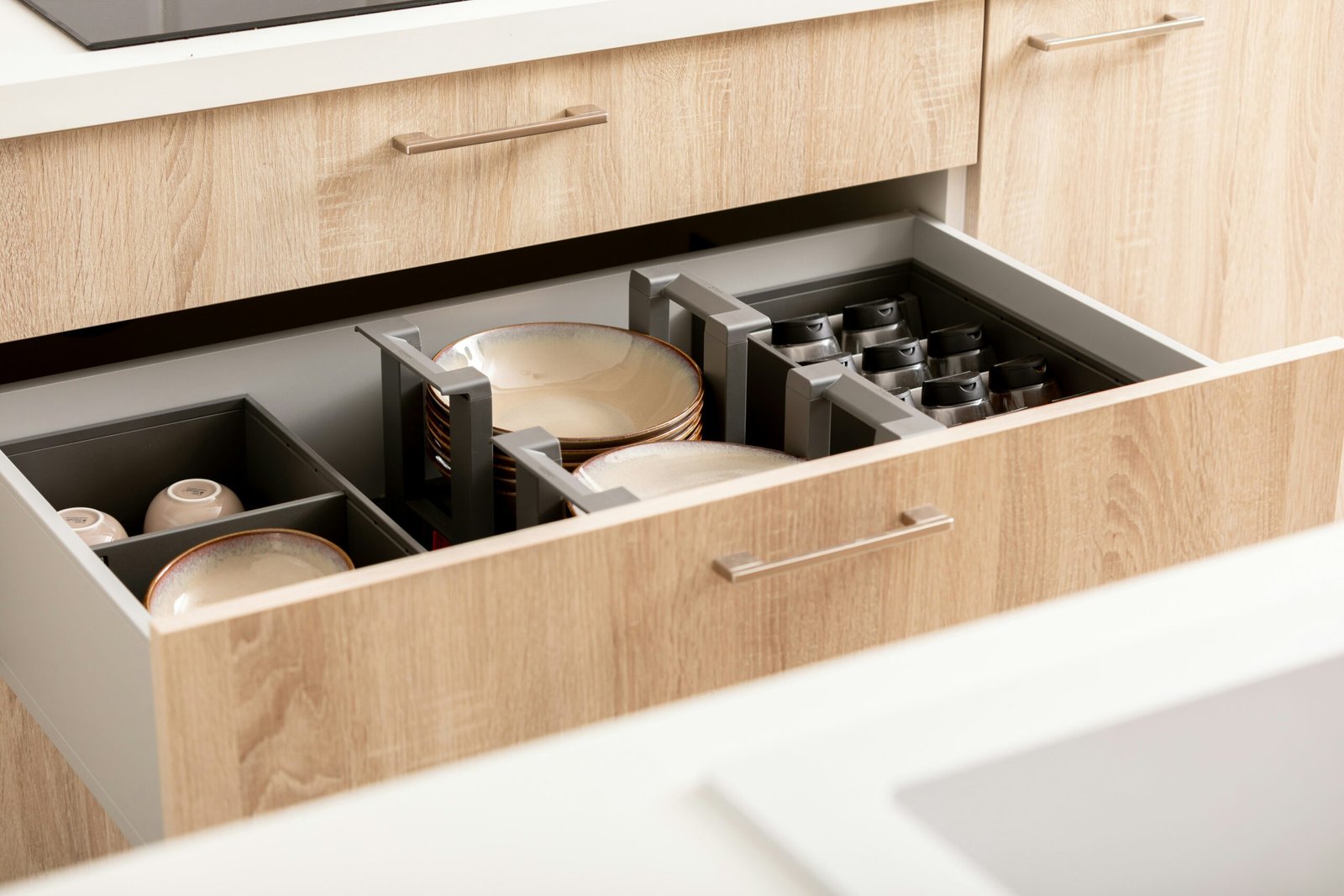Understanding the Challenges of a Small Kitchen
A small kitchen can present a unique set of challenges that impact both its functionality and the cooking experience. One primary issue is the limited counter space, which can make food preparation difficult. When countertops are cramped, it becomes challenging to work with multiple ingredients, utilize kitchen gadgets effectively, or even set down cooking tools without cluttering the workspace. This limitation can hinder the efficiency of meal preparation and ultimately discourage culinary exploration.
Additionally, storage issues often plague small kitchens. With a restricted area, finding adequate space for essential kitchen items—such as pots, pans, utensils, and appliances—can be daunting. Traditional storage solutions, like cabinets and drawers, often fail to offer the necessary capacity. Consequently, individuals may find themselves stacking items or relegating essential tools to inconvenient places, leading to frustration during cooking sessions. The lack of organization can also result in misplaced items, which can waste valuable time during meal preparation.
Another challenge associated with a small kitchen is the difficulty in maneuverability. Space limitations can restrict movement, making it hard to navigate while cooking, especially when multiple individuals are present. This confinement not only affects efficiency but can also be a safety hazard, as it limits the ability to quickly access items in emergencies. The overall layout of the kitchen plays a significant role in how easily one can move around and interact with appliances.
Addressing these challenges is essential to creating an effective small kitchen. By understanding these issues, homeowners can implement tailored solutions that enhance organization and maximize functionality. Finding optimal storage solutions, utilizing vertical space, and ensuring ease of access will transform a cramped kitchen into a more effective cooking environment.
Assessing Your Kitchen Layout
To maximize the functionality of a small kitchen, a thorough assessment of the current kitchen layout is essential. The work triangle concept is vital for enhancing efficiency – it refers to the optimal arrangement of the three main kitchen work areas: the stove, sink, and refrigerator. The distance between these stations should form a triangular shape, allowing easy movement between them, thus saving time and effort when cooking.
Start by measuring the dimensions of your kitchen. This includes the length and width of countertops, cabinet placements, and pathways between work areas. Accurately noting these measurements will facilitate an understanding of the available space and help identify potential improvements to the layout. Additionally, consider existing features such as windows, doors, and electrical outlets, as these can greatly influence an effective design.
Identifying problem areas is another critical step in assessing your kitchen layout. Look for spaces that may feel cramped or may obstruct movement when cooking or preparing meals. This could involve overcrowded countertops, inefficient cabinet arrangements, or a lack of adequate storage. Evaluating how you currently use the space will provide insights into necessary changes. For instance, reflect on whether it is easy to access the utensils and ingredients you use most frequently. If items are difficult to reach, consider rearranging or decluttering to enhance your workspace.
Finally, document your findings through sketches or digital tools that can help visualize potential adjustments. By understanding and analyzing your kitchen layout, you will be better equipped to create a more functional and organized cooking environment, ultimately making it easier to prepare meals in a smaller space.
Decluttering: The First Step to Organization
Effective organization in a small kitchen begins with the essential process of decluttering. Without first sorting through your kitchen items, any attempt to organize may become futile. Decluttering allows homeowners to evaluate their possessions critically and determine which items are genuinely necessary for daily use. Start by removing all items from cabinets and drawers, giving you a clear view of what you own. This process can be overwhelming, however, it is crucial for establishing an organized space.
When assessing kitchen items, consider implementing a set of guiding principles. The first involves the frequency of use. Items that are used daily or weekly should be easily accessible. Alternatively, seasonal or less-frequently used items can be stored in less prominent locations. Another strategy is to categorize items by type, such as cooking utensils, small appliances, or baking supplies, which promotes a systematic approach to reorganization.
As you evaluate what to keep, consider the “one in, one out” rule. This principle stipulates that for every new item brought into the kitchen, an old one must be removed. This method not only helps prevent accumulation but also fosters a more conscious approach to purchasing decisions. Additionally, consider donating items that you no longer use or need; this can provide an opportunity for others to benefit from tools that may otherwise languish in your cabinets.
Ultimately, establishing a space that promotes order and functionality requires commitment to regular decluttering. By starting with the removal of excess items and creating a streamlined inventory, you pave the way for a well-organized kitchen. Further, integrating regular decluttering sessions into your routine will help maintain the efficiency and aesthetic of your space. By letting go of what you no longer need, you set the foundation for a more organized, stress-free cooking environment.
Creative Storage Solutions for Small Kitchens
Maximizing storage in a small kitchen can initially seem daunting; however, with innovative solutions, it is entirely feasible to create a functional and organized space. One effective approach is to utilize vertical space. Installing shelves that extend to the ceiling can provide additional storage for cookware, spices, and decorative items while keeping them accessible. Furthermore, wall-mounted magnetic strips can hold knives and small kitchen tools, freeing up valuable counter and drawer space. These simple adaptations can instantly transform how items are stored and accessed, ensuring that everything has its designated place.
Another useful strategy is to make use of the under-sink area. Often overlooked, this space can be optimized by employing stackable bins or pull-out organizers. By categorizing items such as cleaning products, dish towels, or even pots and pans, homeowners can prevent clutter from accumulating in this tight spot. Additionally, consider installing a sliding shelf to make accessing these items easier without excessive bending or searching.
Incorporating multi-functional furniture is also an excellent way to maximize space in small kitchens. For instance, an island or cart can serve as both a prep surface and additional storage. Look for options that include drawers, shelves, or even hooks for hanging utensils. By using furniture that serves dual purposes, you can keep your kitchen well-organized while ensuring that necessary items are always on hand.
Lastly, utilizing the insides of cabinet doors can provide extra storage opportunities. Installing small racks or containers on these surfaces can store items like spices, lids, or cutting boards, making them readily accessible while maintaining a tidy appearance. Through these creative storage solutions, it is possible to transform a small kitchen into a well-organized and functional cooking space, proving that even limited areas can be optimized for efficiency.
Smart Use of Kitchen Accessories
Organizing a small kitchen can often feel challenging, but the strategic use of kitchen accessories can significantly enhance both space efficiency and overall organization. To maximize the limited area available, it is essential to choose accessories that complement a streamlined kitchen environment. One effective approach is to select stackable containers. These containers not only save vertical space but also make it easier to store pantry items, from cereals to dry goods, while maintaining accessibility. Clear containers can enhance visibility, enabling users to quickly locate necessary items without rummaging through clutter.
Magnetic strips provide another innovative solution for optimizing space in a compact kitchen. By mounting magnetic strips on walls or the undersides of cabinets, users can store metallic utensils, such as knives and measuring spoons, directly where they are needed most. This not only declutters drawers but also ensures that essential tools are readily accessible during cooking activities. For those with limited drawer space, consider investing in multi-functional kitchen gadgets. Tools that perform multiple tasks, such as a combined grater and slicer, can reduce the total number of individual accessories required.
Moreover, utilizing hooks or pegboards can help free up counter spaces while maintaining organization. These accessories can hold not just utensils but also pots and pans, with easy access and improved visibility. In addition, drawer organizers can be customized to fit specific kitchen drawers, allowing for optimal spacing and arrangement of kitchen tools. By employing these key strategies with thoughtful kitchen accessories, individuals can create a more functional and organized kitchen, effectively maximizing their limited space and enhancing their cooking experience.
The Importance of Zones in Kitchen Organization
Kitchen organization is essential for maximizing space, especially in smaller kitchens where every inch counts. One highly effective technique for achieving this is the ‘zoning’ method. This approach involves dividing your kitchen into distinct areas based on specific functions, allowing for a more streamlined workflow and enhanced efficiency during meal preparation and cooking.
In a well-organized kitchen, food preparation, cooking, cleaning, and storage can be more easily managed by establishing clear zones. The preparation zone should be located near your cutting boards, knives, and mixing bowls to allow for efficient meal assembly. This can be situated close to the cooking area, which should house the stove and pots, minimizing the distance necessary to transfer ingredients.
Next, it is important to set up a cleaning zone that is conveniently located near the sink and trash disposal area. Having cleaning supplies, dish soap, and towels within arm’s reach simplifies the process of cleaning up after meals. Finally, the storage zone, typically comprised of cabinets and shelves, should be strategically placed to house cooking and dining utensils, food items, and other kitchen necessities.
By creating these functional zones, you can drastically improve your kitchen’s overall usability. This organization strategy not only enhances the efficiency of everyday tasks but also helps minimize clutter and chaos. An organized kitchen where items are easy to find leads to less frustration and greater enjoyment during your cooking endeavors. Ultimately, effective zoning can transform a small kitchen into a well-oiled machine that maximizes space and enhances productivity.
Color and Design Considerations for Small Kitchens
When it comes to designing a small kitchen, color and design choices play a crucial role in creating a sense of spaciousness and cohesion. Selecting the right paint colors can significantly impact how expansive a small kitchen feels. Light and neutral palettes, such as whites, creams, soft grays, and pastels, can reflect natural light and give the illusion of a larger space. Conversely, darker colors might absorb light and make a compact kitchen feel more confined. Therefore, opting for lighter shades for walls and ceilings is often a prudent choice in maximizing the visual space.
In addition to paint, the design of cabinets is fundamental in maintaining an airy atmosphere. Shaker-style cabinets can provide a timeless look while still keeping the overall aesthetic uncluttered. Cabinet designs that extend up to the ceiling can create a seamless flow and eliminate the need for bulky furniture pieces. Using glass-front cabinetry can also break up solid blocks of color, offering a glimpse into organized interiors, which adds to the sense of space. Moreover, open shelving is an effective alternative that not only showcases decorative items but encourages a more open feel in an otherwise compact area.
Another essential aspect to consider is the choice of decor and accessories. Select items that are both functional and aesthetically pleasing. For instance, using multi-functional kitchen tools can help minimize clutter on countertops and maintain a neat appearance. Additionally, incorporating mirrors or reflective surfaces can amplify light and make the space seem larger than it is. Accessories should be chosen in coordination with the overall color scheme to ensure that every piece contributes to the greater cohesion and harmony of the small kitchen environment.
Maintaining Your Small Kitchen Organization
Once a small kitchen has been effectively organized, maintaining that order becomes essential to ensure the space remains functional and efficient. Daily habits can make a significant difference in promoting ongoing organization and cleanliness. One effective strategy is to establish a routine cleaning schedule. For example, dedicating a few minutes at the end of each day to clean countertops, wipe down appliances, and put away any items used can prevent clutter from accumulating and help keep your kitchen tidy.
Incorporating a system for scheduled decluttering can also enhance the organization of your small kitchen. This could involve setting aside a specific time—perhaps once a month—to evaluate pantry and fridge contents, discarding expired items, and redistributing the rest for easier access. By regularly reassessing what you have and ensuring that only necessary items remain, you can create a more functional cooking environment.
Leveraging checklists can be another effective tool in maintaining kitchen organization. Creating a weekly checklist that includes tasks such as tidying the pantry, organizing kitchen tools, and checking the inventory for groceries can serve as a helpful reminder of what needs to be accomplished. It is essential to revisit your organizational methods periodically, adapting them as necessary to accommodate any new items or changes in your cooking habits. This adaptability ensures that your kitchen remains optimized for efficiency and convenience.
In summary, maintaining organization in a small kitchen involves consistent cleaning routines, regular decluttering, and the use of practical checklists. By developing these habits, you can effectively ensure that your kitchen remains an orderly and enjoyable space in which to prepare meals.
Inspiration: Real-Life Examples of Organized Small Kitchens
Transforming a small kitchen into an efficient and stylish space is entirely possible, and numerous real-life examples illustrate successful small kitchen makeovers. One exemplary transformation features a compact urban kitchen that was dark and cramped, hindering functionality. By removing a bulky island and introducing open shelving, the owners significantly improved the flow and accessibility of the area. The addition of bright, light-colored cabinets and strategically placed mirrors enhanced the visual openness, making the kitchen appear larger.
Another inspiring case involved a galley kitchen notorious for its lack of counter space. The homeowners opted for a complete overhaul by installing pull-out shelving and multi-functional furniture. A foldable table now serves dual purposes, functioning both as a dining space and extra preparation area when needed. Incorporating small appliances into cabinetry also minimized clutter, allowing for a tidy and organized countertop.
Yet another remarkable example showcases a small kitchen that utilizes vertical space to its fullest potential. The installation of floor-to-ceiling cabinetry not only maximizes storage but also lends a modern aesthetic to the room. Additionally, cleverly organized drawer systems keep pots, pans, and utensils within easy reach, reducing the need for excessive bending or stretching. By using a color palette that blends with the walls, the cabinets create a seamless look that contributes to the illusion of spaciousness.
These real-life case studies reveal that with strategic planning and creative solutions, small kitchens can be transformed into functional and appealing environments. By incorporating features such as open shelving, multi-functional furniture, and effective use of vertical space, homeowners can significantly enhance their kitchen organization. These examples serve as practical inspiration, encouraging readers to envision how they can adapt similar strategies to optimize their own small kitchen spaces.











